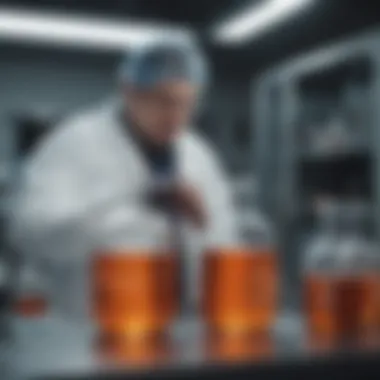Exploring Strong Peroxide: Chemistry and Applications


Intro
The study of strong peroxide is an essential topic in modern chemistry. Strong peroxides, particularly hydrogen peroxide and organic peroxides, are remarkable compounds with diverse applications. This article seeks to dissect various aspects of strong peroxide, focusing on their chemical properties, safe handling protocols, and real-world applications. The understanding of these components is crucial, as they play a significant role in industrial processes, environmental safety, and health implications.
Research Highlights
Key Findings
- Chemical Properties: Strong peroxides are characterized by their high oxidative potential. Hydrogen peroxide, for example, is a versatile oxidizing agent. It readily decomposes to water and oxygen, making it useful in various applications. Organic peroxides possess alkyl groups, affecting their stability and reactivity.
- Handling Protocols: The safe handling of strong peroxide is paramount due to its reactive nature. It is essential to store these compounds in stable conditions, avoiding heat and light exposure to prevent decomposition. Wearing appropriate personal protective equipment (PPE) is also necessary for anyone working with these substances.
- Applications: Strong peroxides have a wide range of applications. In the industrial sector, they are used as bleaching agents in textiles and paper manufacturing. In healthcare, hydrogen peroxide is utilized for sterilization and disinfection purposes. Organic peroxides find their use in the production of plastics and explosives.
Implications and Applications
The implications of strong peroxide in environmental safety cannot be overstated. Improper disposal can lead to ecological harm, highlighting the need for stringent regulations. Additionally, the awareness of health risks associated with strong peroxide is vital for users. Understanding their reactivity can lead to safer practices in laboratories and industries alike.
"Hydrogen peroxide is not just a common disinfectant; its potential as an oxidizing agent extends to exciting applications in modern research and industry."
Methodology Overview
Understanding the application of strong peroxides requires a clear methodology. This section discusses the research design and experimental procedures necessary to study and utilize these substances.
Research Design
The research typically involves both theoretical evaluations and practical experiments. Analyzing the chemical behavior of strong peroxides under various conditions is essential. Lab settings are often employed to monitor reactions and stability.
Experimental Procedures
In practice, experiments may include:
- Synthesis of Organic Peroxides: Controlled conditions are maintained to safely produce organic peroxides.
- Oxidation Reactions: Testing the efficacy of different strong peroxides in oxidation reactions provides insight into their practical applications.
- Stability Testing: Assessing the stability of various peroxide compounds is key to determining their safe usage in industrial applications.
This careful examination of both the methodology and applications of strong peroxides lays the groundwork for a deeper understanding of their scientific relevance and practical implications.
Further exploration of these themes will be detailed in the following sections.
Foreword to Peroxides
The realm of peroxides is a significant area within chemistry, especially considering their myriad applications. Peroxides are compounds that contain an oxygen-oxygen single bond, making them unique among other classes of compounds. This article seeks to explore the multifaceted nature of strong peroxides, including their definitions, types, and chemical properties, which are pivotal in numerous fields. Understanding these components is crucial for both academic pursuits and industrial applications.
Definition and Composition
Peroxides are defined as chemical compounds that contain a peroxide functional group, characterized by a single bond between two oxygen atoms. The simplest example is hydrogen peroxide, which has the formula O2. The unique arrangement of atoms provides a higher oxidation state compared to most oxygen species. This composition underlines their reactivity and versatility in various chemical processes.
Types of Peroxides
Hydrogen Peroxide
Hydrogen peroxide is perhaps the most recognized form of peroxide. It is a colorless liquid with distinctive oxidizing properties. The major aspect of hydrogen peroxide is its ability to act as a powerful oxidizing agent in chemical reactions. This feature makes it invaluable in fields like medicine for disinfecting wounds and in industries for bleaching processes. Moreover, its unique ability to decompose into water and oxygen makes it environmentally preferable when compared to many other oxidizing agents. However, its stability can be a concern under certain conditions, requiring careful management.
Organic Peroxides
Organic peroxides, which are peroxides containing carbon, play numerous roles in both laboratory and industrial settings. They are commonly used as initiators for polymerization reactions. The primary characteristic of organic peroxides is their capability to release free radicals when decomposing. This property is advantageous in manufacturing synthetic materials. However, their potential for explosive degradation under specific conditions presents a challenge. Understanding these properties is essential to safely utilize organic peroxides in various applications.
Chemical Properties


Oxidizing Agent Characteristics
One significant feature of strong peroxides is their role as oxidizing agents. In chemical terminology, an oxidizing agent gains electrons from other substances, often leading to the breakdown of complex molecules. This characteristic enhances their utility in processes requiring the breakdown of organic materials. Their strong oxidative nature is particularly beneficial in disinfection protocols and chemical synthesis, affirming their relevance in both research and commercial applications.
Stability Factors
Stability factors of peroxides vary widely among different types; for instance, hydrogen peroxide is relatively unstable, particularly in light and heat, which can speed up its decomposition. In contrast, some organic peroxides are designed to be stable under normal conditions but can become hazardous when subjected to heat or impact. Understanding these stability factors is imperative for those handling these substances, ensuring both safety and effectiveness in their application.
"Knowledge of the composition and stability of peroxides is crucial for their practical and safe utilization in various fields."
Production of Strong Peroxides
Strong peroxides are essential for various applications, ranging from industrial processes to advanced research. Understanding their production methods helps clarify the capabilities and limitations of these compounds. The synthesis of strong peroxides involves precise techniques designed to ensure purity and stability, both crucial for their effectiveness in different settings. Moreover, as demand for strong peroxides grows, efficient and safe production methods become ever more important.
Synthesis Methods
Electrochemical Generation
Electrochemical generation is a prominent method for producing strong peroxides, particularly for hydrogen peroxide. This technique employs electric currents to oxidize a precursor, which results in the formation of peroxide. One key characteristic of this approach is its ability to produce peroxides in situ, which can be advantageous in many applications, especially where purity is paramount.
This method is beneficial due to its ability to minimize the presence of contaminants typically found in chemical processes. The unique feature of electrochemical generation lies in its sustainability; it requires less hazardous materials, making it a favored choice in both industrial and laboratory settings. However, scaling up this method can present challenges, such as controlling the reaction conditions to optimize yield.
Chemical Methods
Chemical methods for synthesizing strong peroxides encompass various traditional reactions, often utilizing peroxide precursors combined with strong oxidizing agents. This approach is widely recognized for its efficiency in producing larger quantities of peroxides. A key characteristic of chemical methods is their versatility; different chemicals can be employed to tailor the production process to specific needs.
The unique feature of chemical methods is their established protocols, which can be easily replicated in many settings. They allow for the production of a broad range of peroxide compounds. However, these methods may introduce impurities into the final product, potentially affecting the efficacy of peroxides in sensitive applications. Therefore, careful attention to reaction conditions and purifications is vital.
Purity and Quality Control
In the production of strong peroxides, maintaining high levels of purity is non-negotiable. Contaminants can significantly influence both the performance and safety of the peroxide. Quality control measures must be in place throughout the production process. Mitigating risks represents a major priority, especially as these compounds are employed across multiple sensitive applications, including healthcare and electronics. Regular testing and strict adherence to safety protocols are essential to ensure that the produced peroxides meet the necessary standards for their intended uses.
Applications in Various Fields
The application of strong peroxides extends across multiple domains, showcasing versatility and effectiveness in both industrial and research settings. Understanding these applications is crucial for harnessing the potential of strong peroxides while ensuring safety and optimal outcomes. From manufacturing processes to healthcare uses, strong peroxides such as hydrogen peroxide have a significant impact on efficiency and safety.
Industrial Uses
Textile and Paper Production
In textile and paper production, strong peroxides, notably hydrogen peroxide, are used primarily as bleaching agents. This application is crucial for achieving desired color specifications while maintaining fabric integrity. The bleaching process relies on the oxidizing properties of hydrogen peroxide, allowing fabrics to achieve whiteness and brightness without damaging fibers. This method is environmentally friendly compared to other harsh chemicals.
A key characteristic of this application is its effectiveness as a bleaching agent. It can break down color compounds without the toxicity associated with chlorine bleach. Additionally, hydrogen peroxide decomposes into water and oxygen, which reduces environmental impact. However, the concentration levels must be managed carefully to prevent any degradation in textile quality. Hence, controlling the concentration and ensuring proper application techniques is essential for maximizing benefits while minimizing potential disadvantages.
Disinfection and Sterilization
Disinfection and sterilization represent another vital area for applying strong peroxides. Hydrogen peroxide is extensively used in health care settings, food production, and water treatment systems. Its role as a disinfectant is based on its ability to oxidize microbial cell components, thus rendering them inactive.
A remarkable aspect of this application is its rapid action against a broad spectrum of pathogens, including bacteria, viruses, and fungi. The use of hydrogen peroxide as a disinfectant is gaining popularity due to its effectiveness and the absence of harmful residues. However, one must consider the concentration used, as higher concentrations can be hazardous to surfaces and require proper handling.
Research Applications
Analytical Chemistry
In analytical chemistry, strong peroxides like hydrogen peroxide serve as oxidants in various testing methods. Their ability to participate in redox reactions enhances the detection of specific compounds. This utility makes them essential in the development of certain analytical techniques.


The characteristic that stands out in analytical applications is their specificity. Strong peroxides can facilitate reactions that enable the quantification of substances at low concentrations. This specificity contributes to more accurate results in chemical analyses. Nevertheless, careful consideration of reaction conditions is critical, as uncontrolled reactions can lead to false readings.
Material Sciences
Material sciences benefit from strong peroxides in areas such as polymer production and surface modification. Their use in creating peroxides as initiators for polymerization processes showcases their role in advancing material properties. The unique feature of this application involves their capacity to generate free radicals, which are crucial in initiating polimer chain reactions.
The advantage of using strong peroxides in this context lies in their ability to tailor the properties of newly formed materials, such as enhancing strength or flexibility. However, the handling of these substances requires caution due to their reactive nature, which may pose risks if not managed properly.
Medical and Healthcare Applications
Wound Care
In wound care, hydrogen peroxide is used for cleaning and disinfecting injuries. Its bubbling action helps remove debris, and this effervescence can aid in the debridement of wounds, making it easier to treat injuries effectively. The characteristic of this application is its dual function, providing both cleansing and antiseptic properties.
Its unique feature is that while it effectively cleans wounds, the effervescence created helps lift debris. Despite its benefits, caution is necessary because use in high concentrations can damage healthy tissue, slowing down the healing process. Therefore, using it in controlled concentrations is essential for safety and effectiveness.
Antimicrobial Treatments
Antimicrobial treatments utilize strong peroxides to fight infections. This application is especially relevant in treating bacterial infections, where hydrogen peroxide can reduce microbial populations. Its efficacy against resistant strains makes it a valuable option.
The key characteristic here is the broad-spectrum activity of hydrogen peroxide against various pathogens. This attribute makes it a beneficial choice in developing antimicrobial treatments. However, it is important to consider the concentration, as some strains may develop resistance over time. Prudence in application and continuous monitoring is advised to maintain effectiveness.
Safety and Handling Procedures
Safety and handling procedures are critical when working with strong peroxides. These substances, while extremely useful, can present serious hazards if not treated properly. Understanding these procedures not only protects the individual but also promotes a safer working environment. In this section, we will address essential practices and considerations necessary for managing strong peroxide safely.
Hazard Identification
Physical Hazards
Physical hazards of strong peroxides include the potential for explosive reactions and severe burns. One of the key characteristics of these chemicals is their high reactivity. This can result in spontaneous combustion or detonation when mixed with incompatible substances. This is important for those who handle it in any context, as the risk of physical injury is significant. Strong peroxides require proper storage in cool, dry locations away from light, as these factors can enhance reactivity. While strong peroxides bring benefits like efficient oxidation, their handling demands utmost caution due to their volatile nature.
Health Risks
Health risks associated with strong peroxides are also significant. The exposure can lead to skin burns, respiratory issues, and eye damage. One notable characteristic of these health risks is that they often manifest with little warning. For instance, a person may experience skin irritation just moments after contact. This aspect makes understanding health risks crucial for all users. Immediate awareness can result in quick action, potentially minimizing damage. Thus, the dangers posed by health risks underscore the importance of thorough training for those who work with strong peroxides, as the consequences can be severe.
Personal Protective Equipment
Goggles and Face Shields
Goggles and face shields are essential components of personal protective equipment (PPE) when working with strong peroxides. These devices protect against splashes that can occur during handling or reactions. A primary characteristic of goggles is that they create a seal around the eyes, preventing any chemicals from entering. This is critical, as ocular exposure to strong peroxide can lead to irreversible damage. Furthermore, face shields provide additional coverage. They are particularly beneficial during operations that may involve more vigorous reactions, which might spray chemicals outward. Overall, using these PPE items is not just recommended, but necessary for safe practice in environments where strong peroxides are present.
Protective Clothing
Protective clothing is another vital aspect of safety when handling strong peroxides. This clothing often includes chemical-resistant lab coats or overalls designed to prevent skin contact. A notable characteristic of protective clothing is the materials used; these are often designed to withstand chemical penetration. This type of equipment is crucial for minimizing skin exposure during spills or accidents. While effective, an inherent disadvantage is that such clothing can be cumbersome, leading to discomfort. However, the protection they afford far outweighs this concern. In essence, wearing protective clothing is a fundamental practice for anyone engaged in work with strong peroxides.
Emergency Procedures
Spill Response
In the event of a spill, a swift and effective response is vital. Proper spill response protocols are crucial to mitigate risks posed by strong peroxides. A key characteristic of a successful spill management strategy involves immediate containment of the area. This can prevent the spread of the hazardous material. Organizations typically employ spill kits specific to chemical spills, including absorbent materials and neutralizing agents. One advantage of having these kits readily available is that they speed up the response time during an emergency, limiting potential damage. The unique feature of thorough training ensures that all personnel understand how to deploy these resources effectively.
First Aid Measures
First aid measures for exposure to strong peroxides are essential to address potential injuries swiftly. A key characteristic of these measures is that they must be implemented immediately to effectively mitigate damage. For instance, flushing exposed skin or eyes with plenty of water for at least 15 minutes can often reduce the severity of a reaction. This process is vital, as the longer the peroxide is allowed to remain in contact, the greater the potential for injury. It's important to remember that first aid is not a substitute for medical treatment. However, timely action can minimize health risks. Consequently, an understanding of these measures must be an integral part of safety training for any personnel working with strong peroxides.


In summary, safety and handling procedures surrounding strong peroxides are indispensable. Adequate understanding and implementation of hazard identification, personal protective equipment, and emergency procedures create a robust framework for safe practices.
Environmental Considerations
Environmental considerations are crucial when examining the use of strong peroxides. The effective application of these chemicals in various industries must be balanced with their ecological impact. Understanding how peroxides decompose and the byproducts generated is essential for developing sustainable practices. Recognizing the need for responsible disposal and management of waste is equally significant.
Decomposition Products
Impact on Ecosystems
The decomposition of strong peroxides can have varied effects on ecosystems. When applied properly, these compounds can help in cleaning processes without leaving harmful residues. Strong peroxides typically break down into water and oxygen, which are less harmful to natural habitats compared to many other chemicals. This makes them a favorable option for environmental remediation efforts. However, in excess, these compounds might lead to oxygen depletion in water bodies. This characteristic is vital as it presents both benefits and risks for aquatic life.
Byproducts of Use
Moreover, the byproducts created during the utilization of strong peroxides warrant attention. In many cases, the primary byproducts include harmless substances. However, improper handling or overuse can result in a release of reactive intermediates or unstable compounds that may pose environmental concerns. Highlighting the potential for such byproducts underscores the importance of strict application guidelines. Novel approaches to using strong peroxides might significantly minimize the formation of harmful byproducts, aligning with greener industrial practices.
Waste Disposal Regulations
Waste disposal regulations play a significant role in the responsible management of strong peroxides. Clear guidelines ensure that residual peroxides do not create adverse effects on the environment. Regulatory frameworks help industries develop standardized procedures for disposal, reducing the risk of accidental exposure or contamination. Complying with these regulations is not merely a legal obligation; it is a moral responsibility to protect ecosystems while benefiting from the properties of strong peroxides. Ensuring proper disposal aligns with the overall goal of maintaining environmental integrity while utilizing these potent chemicals.
Future Trends in Peroxide Research
The realm of peroxide research is evolving swiftly, driven by advancements in chemistry and a growing understanding of its diverse applications. Exploring future trends in this topic is crucial, considering the significant implications for industries and environmental safety. As we delve into this section, we will highlight key innovations and emerging applications that promise to redefine how we utilize strong peroxides in various fields.
Innovations in Synthesis
Innovations in the synthesis of strong peroxides can have a profound impact on their utility and effectiveness. One focus area is the development of greener synthesis methods. Traditional processes for producing peroxides often involve hazardous materials, posing risks to both health and the environment. New approaches strive to minimize these dangers by utilizing safer reactants or optimizing existing methodologies.
For example, electrochemical methods are gaining popularity. These methods use electricity to drive chemical reactions, potentially leading to a more sustainable production process. The goal is to produce high-purity peroxides while reducing waste and energy consumption.
Additionally, researchers are looking into the incorporation of nanotechnology in peroxide synthesis. This approach can enhance reactivity while allowing for greater control over particle sizes and shapes. Such innovations could lead to stronger and more stable peroxide compounds, leading to improved performance in various applications.
Emerging Applications
Emerging applications of strong peroxides are increasingly finding relevance in multiple sectors. One significant area is in the field of renewable energy. Strong peroxides can serve as efficient oxidizing agents in fuel cells, which are vital for clean energy technology. Their use can lead to improved energy conversion efficiencies, making them attractive for advanced energy systems.
Moreover, in the context of environmental remediation, strong peroxides show promise in breaking down pollutants. Their oxidative properties are beneficial for degrading complex organic contaminants, helping to restore polluted sites. The industrial applicability of these compounds is broad, ranging from wastewater treatment to soil decontamination.
In healthcare, ongoing research aims to explore novel formulations of peroxides for antimicrobial therapies. These formulations can potentially enhance the efficacy against resistant bacterial strains, addressing a significant need in modern medicine.
"The advancement in peroxide applications reflects an integrative approach to solving pressing global challenges, from health care to environmental issues."
By recognizing and investing in these trends, stakeholders can position themselves at the forefront of peroxide research, ensuring not only innovation but also addressing pressing societal and ecological challenges. The future of strong peroxide technology holds extensive promise, and as research progresses, it will become increasingly pivotal across various sectors.
End
The conclusion of this article serves as a pivotal segment that synthesizes the abundance of information covered regarding strong peroxide. It underlines the significance of understanding this compound in various facets of life, from its chemical properties to practical applications in diverse fields. Notably, grasping the dual nature of strong peroxide—as both a powerful oxidant and a source of potential risks—is essential for effective and safe usage.
Summary of Key Insights
This article highlighted several core insights:
- Chemical Versatility: Strong peroxides exhibit a unique reactivity pattern, making them invaluable in industrial production and various research processes.
- Applications are Ubiquitous: From disinfection in healthcare to aiding in material science, the presence of peroxides spreads across multiple domains.
- Safety is Paramount: Understanding the hazards associated with peroxides is crucial for anyone handling these chemicals. Proper protocols must be in place to mitigate risks.
- Environmental Impact: Awareness of the ecological consequences of peroxide use plays a critical role in sustainability efforts. The disposal method and potential byproducts from peroxide use must be considered seriously.
The Importance of Responsible Use
The responsible use of strong peroxide cannot be overstated. As we navigate an increasingly complex landscape of chemical applications, maintaining a balance between utility and safety is essential. Users should consider:
- Personal Safety: Adequate training and protective measures must be adopted to prevent accidents when dealing with strong oxidizing agents.
- Environmental Responsibility: The potential for harmful byproducts necessitates careful waste disposal practices to protect ecosystems and public health.
- Regulatory Compliance: Aligning with local and international regulations ensures the safe handling and usage of strong peroxide, reinforcing best practices within various industries.
In summary, this article presents strong peroxide not merely as a chemical compound but as a multifaceted tool. By fostering a responsible approach toward its applications, we can leverage its benefits while effectively minimizing the associated risks.



